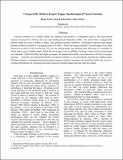Categorically defined targets trigger spatiotemporal visual attention
Author(s)
Wyble, Brad; Bowman, Howard; Potter, Mary C.
DownloadPotter_Categorically defined.pdf (496.6Kb)
OPEN_ACCESS_POLICY
Open Access Policy
Creative Commons Attribution-Noncommercial-Share Alike
Terms of use
Metadata
Show full item recordAbstract
Transient attention to a visually salient cue enhances processing of a subsequent target in the same spatial location between 50 to 150 ms after cue onset (K. Nakayama & M. Mackeben, 1989). Do stimuli from a categorically defined target set, such as letters or digits, also generate transient attention? Participants reported digit targets among keyboard symbols in a changing array of 8 items. When 1 target preceded a second target in the same location at a stimulus onset asynchrony of 107 ms (but not 213 ms), the second target was reported more often than in a condition in which there was no leading target. When the 2 targets were at different locations, report of the second target was impaired. With both letters and digits as targets, the enhancement effect was shown not to be due to category priming. Critically, the attentional benefit was present whether or not participants reported the leading target. Transient attention, contingent attentional capture, popout, and Lag 1 sparing in the attentional blink may involve a common mechanism for orienting processing resources towards salient and task relevant stimuli.
Date issued
2009-04Department
Massachusetts Institute of Technology. Department of Brain and Cognitive SciencesJournal
Journal of Experimental Psychology: Human Perception and Performance
Publisher
American Psychological Association
Citation
Wyble, Brad, Howard Bowman, and Marcy C. Potter. "Categorically defined targets trigger spatiotemporal visual attention." Journal of Experimental Psychology: Human Perception and Performance, Vol 35(2), Apr 2009, 324-337.
Version: Author's final manuscript
ISSN
0096-1523